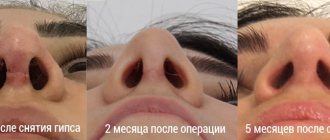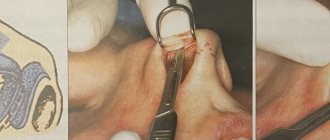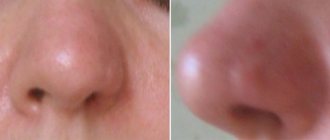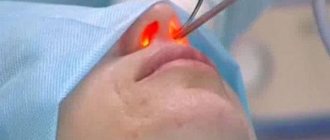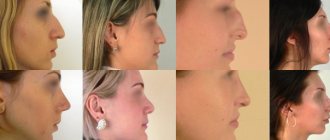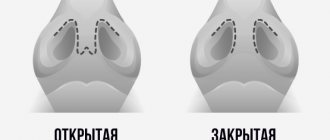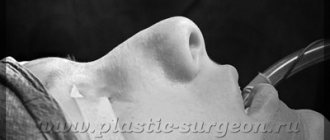Consultation with plastic surgeons with over 20 years of experience – free! Sign up by phone. Waiting for you! Rhinoplasty (nose job) is one of the most difficult operations in the field of plastic surgery. With this operation, you can create a more correct shape of the nose from an aesthetic point of view: reduce it, remove the hump, correct the tip of the nose, etc.
Before undergoing rhinoplasty (nose job), the patient needs to understand that the desired shape of the nose may simply not suit his face type. Therefore, before surgery, it is often better to do a computer simulation of the future result, which helps to assess how the new shape of the nose will combine with the proportions of the patient’s face.
Anatomy of the nose
Anatomically, the human nose consists of three sections: the external nose, the nasal cavity and the nasal sinuses. The external nose is the part of the nose that we see. It is a bone-cartilaginous skeleton covered with skin. Between the oral cavity and the anterior cranial fossa is the nasal cavity. Here, in anticipation of the nasal cavity, thanks to numerous hairs on the skin, the air is cleared of debris, then enters the respiratory area, where the nasal passages are covered with mucous membrane with ciliated epithelium. When exposed to irritants, the mucous membrane swells and the nasal passages close. The anatomy of the nose also includes cavities in the bones of the skull that communicate with the nasal cavity, which are called paranasal sinuses.
Difference between nasal tip surgery and full rhinoplasty
The external nose (which the plastic surgeon works with) consists of three layers of tissue: the outer skin, the osteochondral skeleton (the skeleton of the nose), and the inner epithelial lining. The dorsum of the nose is formed by bones and partly by cartilage; the tip and wings of the nose consist entirely of cartilaginous tissue.
⇒ INFORMATION: Medical indications for correcting the shape of the nose
The essence of rhinoplasty is the correction of the bones of the nasal dorsum, septum and tip cartilage. Correction consists of working only with small cartilages: changing their shape (reducing or lengthening), size and angle of inclination.
There is a difference in the rehabilitation period: after complete rhinoplasty, the patient must wear a splint for 10-11 days; after cartilage correction, the new resulting shape is fixed with strips - special adhesives.
⇒ INFORMATION: Rhinoplasty - get rid of annoying snoring
Indications for rhinoplasty
The main indication for rhinoplasty is aesthetic dissatisfaction with the shape of the nose, namely:
- high or wide bridge of the nose;
- hump on the osteochondral section;
- wide nose;
- rounded or drooping tip of the nose;
- asymmetry of the nostrils;
- deviated nasal septum.
Today, the main trend is the “Europeanization” of the nose, when the bridge of the nose is low and even, the tip is narrower. Often the reason for rhinoplasty is post-traumatic or congenital deformities, which lead to disruption of the aesthetic appearance and dysfunction of the nose. This can be a complex problem - not only with the nasal septum, but also with the nasal concha and mucous membranes.
Preparing for surgery
Before proceeding with the operation, the plastic surgeon carefully examines the condition of the osteochondral tissues of the nose and decides on the use of autocartilage - natural grafts taken from the patient’s ears, ribs or nasal septum.
If it is impossible to use the patient's cartilage tissue, artificial nasal implants are used, of which there are a large number today. Despite the fact that artificial implants are made from materials that do not cause rejection, rhinosurgeons still recommend using the patient’s own tissue—authentic cartilage. Comment from a plastic surgeon: “Asian surgeons widely use silicone nasal implants in their practice. Asian girls have very small noses, and with the help of reconstructive rhinoplasty, the nose can be enlarged, making it more “European”. However, in my work, I prefer to use the patient’s ear or rib cartilage, since they are not rejected by the body.”
Example of nasal reconstruction
“Do I take on complex cases of revision surgery? Yes, when, when assessing the situation, I understand that it is technically possible to help the person. But there are situations when, after consultation and examination, it becomes clear that it is better not to touch anything. Then I will honestly tell the patient that in his case, repeated surgery is a considerable risk of harm.”
Tamarov Alexey Nikolaevich plastic surgeon
Technique of the operation
There are two schools that develop in parallel and partly compete: the school of open rhinoplasty and the school of closed rhinoplasty. The choice of access depends on the experience and tactics of the operating surgeon. For the patient, the only difference is a small incision on the skin of the nasal septum (columella).
With open access, the incision passes along the columella, with closed access, on the mucous membrane in the vestibule of the nose
Incisions both inside and outside the nose heal quickly and are completely invisible to others.
To gain access to cartilage and bone during correction, closed rhinoplasty In this case, the skin is not separated from the frame. During the operation, miniature surgical instruments are used. For example, to get rid of the “potato” nose shape, the doctor corrects the pterygoid cartilages. Taking into account the required intervention and the structure of the patient's nose, the surgeon uses sutures to tilt or pull the alar cartilages inward, achieving a specific correction. The result is the desired, aesthetically correct shape. The method gives excellent results, the recovery period is relatively short.
Read more about closed rhinoplasty here: https://mosplastica.ru/services/plasticheskaya-khirurgiya/rinoplastika/zakrytaya-rinoplastika/.
Open plastic surgery provides the greatest opportunities for performing surgery at a high level of quality. At the beginning of open surgery, 2 incisions are usually made. A small cut in the columella, the area of tissue that separates the nostrils. Using a retractor to open the inside, the rhinosurgeon makes a second incision, known in surgery as a marginal incision. It runs from the incision in the columella area to one and the other nostril. Using special surgical scissors, the surgeon carefully cuts the skin along an incision in the columella area to separate it from the frame. The incisions make it possible to correctly separate the anatomical components. This ensures complete visualization of the required areas. The doctor has the opportunity to carefully examine the entire frame, make an extremely precise correction of the structure and give the nose the necessary shape. Using advanced operating technology and special medical instruments, the doctor is able to achieve the desired shape when removing or replacing tissue (including implants).
Read more about open rhinoplasty here: https://mosplastica.ru/services/plasticheskaya-khirurgiya/rinoplastika/otkrytaya-rinoplastika/.
Surgeon's comment: “In open rhinoplasty, a small incision is made, after which the skin of the nose is completely folded back and all the structures of the nose are exposed. This access gives very good visualization. For the patient, this access is somewhat more traumatic, because The nasal area is more involved, and in the postoperative period with the open technique, swelling lasts longer. In the future, a small scar remains on the skin, but it is almost invisible. With closed rhinoplasty, all incisions are made inside the nose, on the mucous membrane. But for the surgeon, the operating field is much less visible. A deep knowledge of anatomy is required, because... everything is done almost by touch. Since the result can be obtained equally good with both open and closed surgery, the latter is more popular.”
Advantages of rhinoplasty with Dr. Kudinova:
Ekaterina Sergeeva Kudinova is among the TOP 5 best specialists in Moscow in the field of rhinoplasty and reconstructive nose surgery. Patients from other cities in Russia and abroad often come to her clinic. Some turn to her to have their nose corrected by the best plastic surgeon in Moscow, while others want to undergo complex reconstructive surgery or re-correction of the nose after a previous unsuccessful rhinoplasty.
Ekaterina Sergeevna Kudinova is not just a plastic surgeon who has extensive practical experience in performing all types of rhinoplasty, she is a recognized Russian expert in performing the most complex reconstructive surgeries of the nose and midface. Dr. Kudinova defended her dissertation on the topic of reconstruction of post-traumatic defects and deformities of the midface. For a long time she specialized simultaneously in plastic and reconstructive surgery of the face and nose, working under the guidance of the best Russian and foreign specialists in this field. If you are interested in the price of nose surgery in Moscow, open our price list or contact us by phone.
Over the past years, Dr. Kudinova has been a leading researcher in the department of plastic and reconstructive surgery at one of the leading medical centers in Moscow - the Federal State Budgetary Institution Scientific Center for Otorhinolaryngology. Here she performs the most complex plastic and reconstructive nasal surgeries for patients injured in accidents and accidents. Contacting her is the best solution if you need the best rhinoplasty in Moscow. Our prices for nose correction are quite reasonable.
If you want to find out how plastic surgery can help improve the appearance of your face, sign up for a consultation with a Ph.D. plastic surgeon Ekaterina Sergeevna Kudinova through the online registration form or by phone 1 or +7 (903) 790-69-58.
Suture material and anesthesia
In closed rhinoplasty, the stitches are located inside the nose. The suture material dissolves on its own. In open rhinoplasty, a very thin thread is used for sutures, placed on the skin part of the septum. A clear overlap of the edges is important here in order to obtain the thinnest possible scar after surgery. Naturally, such stitches must be removed.
Rhinoplasty is most often performed using intravenous anesthesia. On average, the operation lasts about an hour, but the time is influenced by the complexity of the case and the desired result. Once completed, the nasal passages are packed and a solid dressing is applied, most often a plaster cast or Denver splint.
Caring for the nasal cavity after surgery
Modern rhinoplasty involves rapid recovery after surgery. No special care is required for the operated area. It is worth following these recommendations:
- the sutures are not removed, since the surgeon uses self-absorbing cosmetic threads;
- when there is discharge, you should carefully clean the nasal passages from accumulated clots with sterile cotton swabs;
- treat the operated area with chlorhexidine solution or other antiseptic to prevent infection of the mucous membrane.
Closed rhinoplasty
Closed rhinoplasty
Rhinoplasty and septoplasty
In addition to the patient's dissatisfaction with the shape of the nose, among the indications for surgery can also be difficulty breathing, which can be caused by an anatomically deviated septum, or a fracture. A deviated septum not only makes breathing difficult, but also provokes the development and long course of otolaryngological diseases. Therefore, aesthetic plastic surgery of the nose is often complemented by ENT surgery and septoplasty: in this case, in addition to correcting the shape, the deviated nasal septum is also corrected in order to facilitate the patient’s breathing.
Read more about septoplasty here: https://mosplastica.ru/services/plasticheskaya-khirurgiya/rinoplastika/septoplastika/.
Septoplasty can be done separately, that is, without performing aesthetic correction. However, as a rule, when performing aesthetic surgery, the septum is always corrected to one degree or another (rhinoseptoplasty). If this is not done, breathing function may deteriorate.
Read more about rhinoseptoplasty here: https://mosplastica.ru/services/plasticheskaya-khirurgiya/rinoplastika/rinoseptoplastika/.
My concept
I perform operations to change the shape, correct imperfections, restore the aesthetics and size of the nose, following the concept of conservation rhinoplasty, which was developed by Turkish rhinosurgeons. They made a real revolution in plastic surgery, changing and improving the canons of traditional operations.
The essence of conservation rhinoplasty is minimal resection (removal) of tissue. The new shape is created through micro-seams. The surgeon resorts to resection to a lesser extent and preserves all the anatomical features of the nose.
The main advantage of this procedure is the predictability of the result. Traditional rhinoplasty comes with certain risks. Preserving plastic fixes the result with minimal complications.
⇒ INFORMATION: Open and closed rhinoplasty: differences and features
Non-surgical rhinoplasty
Minor defects of the nose (small hump, asymmetry, drooping tip) can be corrected with fillers or threads. The undeniable advantage of the procedure is its minimal invasiveness and lower price than surgical intervention. The procedure takes place under local anesthesia, does not cause complications and does not require long-term rehabilitation. Non-surgical rhinoplasty allows you to temporarily change the shape of your nose. The procedure can be repeated, or surgical correction can be planned.
Read more about non-surgical rhinoplasty here: https://mosplastica.ru/services/plasticheskaya-khirurgiya/rinoplastika/bezoperatsionnaya-rinoplastika/.
Photos "Before" and "After"
Correction of the hump and tip of the nose
A slightly upturned tip looks good on a young woman’s face; for older patients, I recommend a laconic straight shape. With the help of plastic surgery, it is possible to shorten, raise, lower, lengthen, widen or narrow the tip of the nose. Reviews about the procedure confirm that even a minor correction changes the proportions of the face and the overall image.
⇒ INFORMATION: How to get rid of a hump on the nose?
Repeated and restorative (reconstructive) nose surgery
All types of congenital disorders, unsuccessful nose corrections performed previously, injuries - all this is the task of repeated, reconstructive (restorative) plastic surgery. Such operations are definitely more complex and less predictable for both the surgeon and the patient. During revision rhinoplasty, you may encounter “surprises” in the form of scar tissue, your own or foreign materials located on the bridge of the nose.
Repeated operations in the nose area can be performed no less than 6 months after surgery, and preferably after a year.
As for broken noses, it is not always possible to restore a completely injured nose, but it is definitely possible to significantly improve the situation.
Revision rhinoplasty is a fairly complex operation and is not performed by every surgeon. To achieve the desired result, the surgeon must be a true professional and have extensive experience in performing such operations. This operation is performed in Moscow, including in our clinic, where the operation is performed by leading specialists with extensive experience. Be careful when choosing a clinic and a surgeon, because repeat surgery (to correct the results of an unsuccessful operation) is quite difficult due to the presence of scar tissue and a possible lack of nasal tissue.
Read more about revision rhinoplasty here: https://mosplastica.ru/services/plasticheskaya-khirurgiya/rinoplastika/povtornaya-rinoplastika/.
What does rhinoplasty include?
Nasal plastic surgery can be performed on patients over 18 years of age. Before the operation, plastic surgeon Kudinova pays great attention to all the details and features of appearance. A thorough inspection and analysis of the right and left profiles is carried out. Mandatory tests and additional preoperative examinations are carried out:
- computed tomogram of the midface,
- orthopantomogram,
- lateral teleroentgenogram (as prescribed by the surgeon).
Before performing a nose operation, the surgeon makes a computer simulation of the result of rhinoplasty so that the patient can see and understand how the appearance of the face can be improved with the help of surgery, whether enlargement, reduction of the nose, or correction of the septum is required. You can find out how much rhinoplasty costs in Moscow here or by calling the phone number listed on the website.
Brief description of the rhinoplasty process:
- Dr. Kudinova’s nose job is usually performed in a closed manner (without visible external incisions);
- The operation is performed under general anesthesia;
- Typically, nose correction takes about 1-2 hours (depending on the complexity);
- The duration may increase if rhinoplasty and other plastic surgery are performed simultaneously;
- After rhinoplasty, the surgeon puts a plaster bandage on the nose, inserts tampons into the nasal passages, and the patient is transferred to the ward.
The usual length of stay in the clinic after nose correction is 1, in the most difficult cases – 2 days. Thanks to the special ability to carry out gentle, minimally invasive operations like a woman, rhinoplasty with Dr. Kudinova is characterized by low trauma and a relatively short rehabilitation period, and at the same time always achieves its goal.
Rhinoplasty of the nose, the price of which depends on the type and extent of correction - see here.
Complex change in appearance. Read more
Nasal implants
Implants for nose reconstruction are made of medical silicone or other synthetic materials. They have a shaped contour and are applied by the surgeon to the bridge of the nose. There are camouflage implants, when a thin film is placed on the bridge of the nose in order to cover all irregularities after rhinoplasty. Synthetic nasal implants are used quite rarely - usually only when it is necessary to increase the bridge of the nose when there is not enough tissue. Most often, rhinoplasty surgeons use cartilage and bone implants (autografts). You can use ear and rib cartilage, as such tissues take root better.
Possible side effects
Any surgical operation carries risks. I openly warn my patients about all the risks and possible complications during consultation. But by entrusting rhinoplasty to professionals, the risks are reduced. Postoperative care and the surgeon’s willingness to resolve possible complications are also important.
Side effects after rhinoplasty include:
- callus,
- nasal deformity,
- tissue inflammation.
Rehabilitation period after rhinoplasty
How long does rehabilitation take after rhinoplasty? The answer to this question largely depends on the patient's postoperative regimen:
- After surgery, it is advisable to stay in the hospital for the first day or two. This will make it easier for doctors to monitor the initial stage of wound healing.
- Then you can go home, but during the first 2 weeks you must come to the clinic for dressing changes every 4 days. In addition to dressings, the doctor monitors how the scarring process progresses.
- It is advisable to stop playing sports for 2 months, and contact sports (boxing, wrestling, etc.) can be started no earlier than six months after the operation.
- There are also restrictions on temperature conditions: for up to two months you cannot warm up, steam, visit baths, saunas, and for the first time you cannot even use a hot hairdryer.
- You need to sleep on your back.
The external consequences of the operation are leveled out after about 2 weeks, but the recovery period takes a little longer.
After rhinoplasty, in which both cartilaginous and bone parts are corrected, swelling and hemorrhage are sure to occur. They usually spread to the area of the lower eyelids, sometimes to the area of the upper eyelids, cheekbones, forming hematomas under the eyes. It takes 12-14 days for them to completely go away. The patient himself, on average, feels for up to two months that he has had surgery in the nasal area.
What factors influence the aesthetic result?
The result is influenced not only by the skill of the surgeon. Factors that are also responsible for a good result: anatomical data and the degree of consciousness of the patient.
What else does the success of the operation depend on?
- Skin thickness. The thicker the skin, the longer the swelling lasts and the results of the procedure do not appear immediately.
- Fragility and elasticity of cartilage. The condition of cartilage depends on the age, lifestyle and genetic characteristics of the patient.
- Injections of hyaluronic acid during non-surgical rhinoplasty in a cosmetologist's office. Fillers used to model the shape of the nose complicate the surgeon’s work and may partially affect the outcome.
- Presence of injuries. Scar tissue is tougher, therefore, it is more difficult to work and model a new shape with scar deformities.
- Following the doctor's recommendations. Alcohol, smoking, and favorite sports should be abandoned for a while.
The importance of septum plastic surgery for your health
A deviated septum can occur both during adolescence and after an injury. Because of this factor, respiratory function is impaired, and we no longer receive enough oxygen. This, in turn, leads to regular rhinitis (runny nose), headaches and even the appearance of tumors in the sinuses, which significantly affects the quality of life. During rhinoseptoplasty, additional manipulations can be performed: perform a vasotomy and relieve the person from “drip” dependence or eliminate a cyst in the sinus. Most patients after rhinoseptoplasty literally begin to breathe deeply and are surprised how they suffered with this all their lives.
